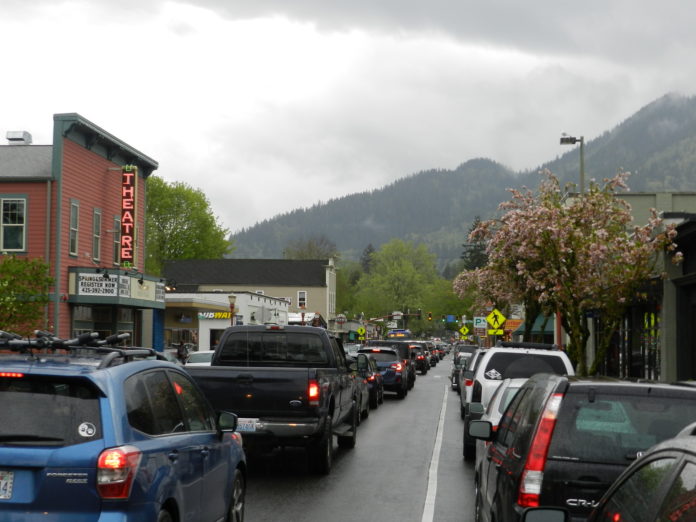
The formerly Golden State’s northern sister is still Evergreen but inexorably in transition to an over-developed and congested slice of Southern California
By Mark Cromer
“If we could get to a billion people here, America would be unstoppable. That would be amazing.”
— Katherine Mangu-Ward, Reason magazine editor, September 2017
Surrendering a quality of life is a curious thing.
Outside of America’s Great Cities, where the metric these days includes muggings, murders and the random mayhem of vandalism as well as spent needles and public defecation, the capitulation is most often marked by a molasses-paced retreat by residents—both old and new—that unfolds day by day, week by week and month by month as the years drip off the calendar and hallmarks like organic open space fade away as the fields disappear, the pastures are paved over and the hillsides buckle under ever larger housing developments while the air thickens amid the idle of growling traffic slowed to a lava flow.
Such was the fate of Californians as they watched the landscape that once reflected the Golden State’s proverbial laid-back lifestyle be supplanted by—incrementally at first and then eventually in a wild orgy of a land rush not witnessed since America’s great push west—a development boom and population surge that will persist to its moment of total collapse. Or as comedian Ron White once replied when asked by the guy in the seat next to him how far a single engine would get the plane they were flying on: “All the way to the crash site.”
It doesn’t take a team of NTSB investigators to discern what happened to California; recovery and analysis of black box data will not be necessary.
Commutes that once took fifteen or twenty minutes have disappeared into hour and a half slogs across networks of freeways that are maxed out while an adequate rail system remains in Sacramento’s perennial gestation of cynical one-party dysfunction. The evaporation of affordable housing stock, now as rare in Southern California as a monsoon season in the Sahara, spawned building sprees of vast tracks of cheaper housing in locales that put living wage jobs often at near triple-digit mile distances from where workers could afford to own a home.
So-called ‘master-planned’ communities sprouted like mushrooms but there seemed precious little notice given to the fact that the masters’ plans called for people to live there but work at an ultimately unsustainable (and unholy) distance away.
And the deep seas of those already decrepit two-story, no yard shit-boxes is still not enough.
California’s Department of Housing and Community Development released a report late last year that projected the state needs to add approximately 2 million new homes over the next seven years to meet the anticipated population growth. And consider that California’s official projection anticipates the bare necessity of accommodating what is effectively between 6 million to 8 million more people poured into a state in a perpetual fresh water crisis that has resulted in an escalating series of water-use restrictions for its current residents.
The perverse policy long emanating from Sacramento holds that Californians, and particularly in the state’s parched south that teems like an anthill that is constantly being kicked, must be in a permanent state of resource crisis for the pleasure of having an uninterrupted stream of more people coming in to join the collective huddle.
Of course there were protestations to this long retreat from a reasonably comfortable quality of life, but far too little and way too late and ultimately of no relevant long-term political consequence to preserve any significant spread of the state’s halcyon days of yore, though incidental relics of that era still remain and can occasionally be glimpsed among the sweeping sprawl of Southern California.
And now it’s the turn of Northern Washington.
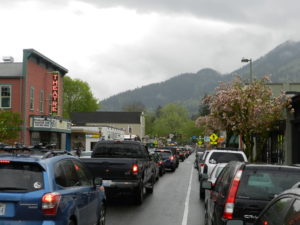
I have been repeatedly reminded of this in Issaquah through the past five years as I find myself pondering the town’s transformation from another vantage point that is reminiscent of my native Southern California: amid stopped-dead, bumper-to-bumper traffic on what were once residential streets as well as the highways and freeways. The roll of Washington State’s Route 900 is of particular note as it slides down the northerly descent between Cougar and Squak mountains and funnels into the gridlock that begins to coagulate as the mountain town’s artery of 17th Avenue hardens and clots with every manner of vehicle the closer it draws to Interstate 90.
At Northwest Maple Street and 17th Avenue, the arterial has long been frequently clogged to the point of risking a civic cardiac event, with motorists watching the series of traffic lights that ostensibly manage the intersections that converge on the approach to I-90 change repeatedly in front of them with little more than one or two car lengths of movement through each cycle. Just a little further east, where the westbound I-90 unloads at Front Street, motorists hooking a left to head south into old downtown Issaquah routinely find themselves in a steel floe as the traffic that’s jammed at Gilman Boulevard by the XXX Rootbeer Drive-in (featuring Buddy Holly’s last tour bus that really isn’t his tour bus, though it is a bus…) brings creaks, cracks and occasionally breaks into an all too brief nudge forward before freezing again.
Once past Gilman drivers can drift past the Darigold dairy (known by a generation of Americans for their ice cream cups) at a brisk 20 mph before the stop n’ go starts again right around Fins, a cozy little higher-end joint next to the Village Theatre. From there it’s gray skies and red lights for the hundred-plus yard run up to Sunset Way.
A small town meets big traffic. And it’s only going to get worse.
With hundreds of new housing ‘units’ under construction in Issaquah that will bring thousands of more residents and their vehicles to the once sleepy mountain town just outside of Seattle, it’s clear that whatever proposed stent that’s offered to buy time along with developer-funded doses of civic morphine to keep the patients calm if not comfortable, the lard of growth will continue to take its toll.
This is what happens in a culture that’s dominated by the cultish mantra of Growth Is Good. Or more aptly: Growth Is God.
Whatever caveats, qualifiers and euphemisms like ‘managed growth’ or ‘smart growth’ or ‘planned growth’ and ‘mitigating measures’ that are attached to that transparently false campaign soundbite turned political truism which is peddled by developers and their perversely-dubbed ‘public servant’ lackeys, when the sole prism through which progress is viewed is growth—be it economic, consumption, development or population—the end result will ultimately be less of a quality of life for pretty much everyone, whether they are third-generation natives or new arrivals fresh out of the cab stand at SeaTac, whether they are tech-rich players with investment homes to boot or two-plus jobber grunts scrambling every month to cover the rising rent on a room in a shrinking universe of what passes as affordable housing in Greater Seattle these days.
It’s a peculiar moment because most everyone in Northern Washington seems to know what’s happening, they possess some grasp of the danger that’s sprouting in front of their very eyes a little more each day, and yet most seem at a loss of what to do about it or perhaps even suspicious at the prospect that something in fact can be done about it. In this era that’s now rather replete with fantastical analogies to Star Wars, complete with an evil Emperor and an oh so noble Rebellion (er, Resistance), when the average resident just east of Puget Sound today considers the rabid growth unfurling around them they probably feel something like Luke Skywalker as he first jelly-fished to Obi-Wan Kenobi about how he couldn’t get tangled up in the fight against The Empire: “I can’t get involved. I’ve got work to do. It’s not that I like The Empire, I hate it, but there’s nothing I can do about it right now.”
And yet in Northern Washington if there is any flickering hope of preserving what’s left of the quality of life that once defined the region as surely as it did in Southern California more than a generation ago, right now is the Last Act of the Last Chance.
Of course, most mornings in places like Issaquah, Sammamish and Snoqualmie still don’t seem to begin with such stark choices requiring absolute decisions. It is still easy to rise and shine amid the gloriously storming skies in this place and time and believe—or at least not difficult to convince oneself—that the moment of reckoning has not only not quite yet arrived, but is still lingering somewhere over the horizon of brake lights that bathe the interstates and many of the roads that feed them.
The growth and its immediate consequences are unavoidable and an increasingly constant irritant, but it can still feel like a relatively low boil. The trees are being cut down, the earth is being torn open and the insta-homes are rising in legion—as surely as the spread of the Zombieland junkies that continue to hive throughout Seattle-Tacoma—but the tipping point remains at least somewhat obscured by the glitter of skylines that tech built and the shimmering tide pools of wealth that continue to unroll along the shoreline.
The development pushers and their growth addicted acolytes will invariably scoff at the premise that Northern Washington is somehow on track to resemble Southern California; pointing to the vast disparity between the regions in population size and the sheer scope of the Left Coast states’ human densities and therefore the degrees of the intractable social ills that accompany more people jammed into a given space. But they are long past disingenuous and have descended to a point of shamelessly occupying the low ground as they work tirelessly to import more and more people into communities all over Northern Washington completely irrespective of the impacts on existing infrastructure and thus the quality of life or the rich character of the rural villages, small towns and the once small cities they’re intent on submerging to the point of drowning for one inescapable reason: pure, unadulterated greed.
So they will offer their own comparisons to refute any suggestion that what’s happening in Northern Washington is anything remotely akin to the bulldozer-driven blowout that has irrevocably rolled over Southern California.
The population of Los Angeles County alone is now well past 10 million people, a number that surpasses Washington’s entire state population of 7.5 million by nearly a third as much. Washington’s signature city, Seattle, with a population hovering under 800,000, isn’t even a quarter of the population of Los Angeles proper, which is now well over 4 million, though LA also has five times the square miles within its city limits. But simply considering the agate of an overall human population with the space that’s ostensibly available to accommodate and sustain it in a vacuum devoid of honest measurements of quality of life indexes is, most charitably, deceiving. The argument that there is still plenty of terra firma to go around in Southern California and Northern Washington can well be made by developers and the public officials they own amid a blizzard of charts, maps, data from commissioned studies, satellite imagery and the forecasts of the most expensive experts that developers, City Hall and the Statehouse can buy.
But it all disintegrates on impact with reality and common sense. Or as the experts like to sniff: ‘anecdotal experiences that provoke emotional responses from residents.’
In January 2011 National Geographic published a nifty little graphic that depicted the fact that every man, woman and child on the planet could fit—were they to stand shoulder-to-shoulder—within a 500-square-mile area, or as they phrased it: “How about the City of Los Angeles?”
NatGeo apparently missed or chose to paste over the underlying point that Angelenos now live everyday with the sinking feeling that much of the world is indeed already living here.
A magazine with a rich and storied history defined by uniquely capturing not only the human experience on planet earth but, more importantly, the cost and consequences of humankind’s spread across the globe for every other species and the habitats that support them was bizarrely reduced to playing what essentially was a developer’s game: using a colorful if meaningless chart to make a bullshit point. One that simply begged the question: ‘So what?’ It was useless trivia employed apparently as some sort of soothing reassurance that there was still plenty of space left for lots more people all over this blue orb we all call home.
It was National Geographic Does Disney.
But a few flips of the pages into National Geographic’s theme issue entitled ‘Population 7 Billion: How Your World Will Change’ finds veteran scientific journalist Robert Kunzig observing confidently “People packed into slums need help, but the problem that needs solving is poverty and lack of infrastructure, not overpopulation.”
It’s such a stunningly simplistic conclusion that it sounds somewhere past a Trump Twitter burp and well into a zealous Maoist slogan of certainty tinged with a threat.
Kunzig goes on to expand a tad on the formula that holds every human can be, geometrically speaking, jammed into Los Angeles, noting that he attended the 2010 annual conference of the Population Association of America in Dallas, where one of his demographic takeaways was that if we wanted to give the entire population of the planet a little more breathing room—say something along the lines of New York City’s density—they would still fit comfortably into Texas. As such, Kunzig figures that by mid-century and with six continents to work with, a population of nine billion-plus would amount to a no more human density level than that of present day France, a European country which he duly notes “is not usually considered a hellish place to live.”
See, for the jet-setting journos that enjoy six-figure salaries (and the always helpful town car service to and from the airport) in compensation for going on safari into the jungle of humankind’s smoldering sprawl to file reassuring dispatches that are crafted well within the bright lines of a politically pre-approved narrative, it really is just that simple. Worried about the vanishing habitat that thousands of species rely upon for mere existence as the human cycle of migrate-swarm-devour-migrate-swarm-devour continues unabated? Let your heart rest easy, for National Geographic has reported the entire population of the planet can fit rather snuggly into Los Angeles, a little more comfortably into Texas and rather lavishly into France, no problemo. If it seems that planet Earth is now literally swimming with people, it only seems that way, and our best minds have determined all will work out in the end, with a little elbow grease and a whole bunch of new apps and tech-bang-whiz stuff they’re cooking up even as you read this from the Silicon Valley in California to Bellevue in Washington.
And that’s worth noting because it’s that very breezy estimation of Kunzig—a casual calculus of a journalist who has walked amid the teeming human swarms of Calcutta for a ripe paycheck but whom, of course, would eat a .357 before he had to actually live there—which percolates at the core of what has happened in Southern California and what is now happening in Northern Washington.
It’s that same casually dismissive attitude—which would never be tolerated professionally or privately in Kunzig’s circle were he to apply it to arguments over climate change—which permeates the official position that governs growth and development in the United States today and particularly on its West Coast. There is indeed a direct correlation between the axis of overpopulation deniers and growth junkies and the degradation of quality of life, whether it’s in the far reaches of the Third World or on the Northwestern seaboard of the United States. It is all interconnected.
For those Washingtonians who feel they can find adequate shelter in the so-called ‘progressive’ genetics of the state’s coastal plain, that somehow the best of intentions will fix it, once more they need look no further than Sacramento, which today is dominated to near exclusivity by what amounts to a politburo of lefty Californians as headed by the Golden State’s version of its own Kingfish: Governor Jerry Brown. As California’s longest serving governor, Brown was in office when California was at its zenith, when its quality of life standard still shone like a beacon that burned perhaps a little too bright. No matter the medicinal-grade of legal THC these days, there’s not enough High Times cover-worthy, epic sensimilla growing in Humboldt that can erase from Brown’s coconut the fact that he ruled the roost back in the day and he surely knows just what a development-driven train wreck he now lords over today.
The days of lighting one up with his chick Linda over a fine Napa bottle are long gone, as is the very landscape that made that wonderland possible. To paraphrase ABC’s Jim McKay in 1972: ‘It’s all gone.’
But if Brown harbors any regrets, let alone recoiling in horror at what’s happened to his beloved California, one would be hard pressed to find it reflecting in any manner or fashion from him publicly. Just this week he issued a statement that was subsequently published in The New York Times bragging that Californians were “Citizens of the fifth largest economy in the world.”
And there it is: Citizens of an economy.
Not citizens of a unique and once beautiful state that had so long been the cutting edge of a nation and its truly golden cultural epoch, not citizens of a resplendent coastal tribe in love with their way of life on the shoreline of the Western world, no, but rather citizens of an economy. Digits on a ledger, beads on an abacus or numbers on a tote board, if Californians these days feel like a number that’s been fed into a machine it’s because they are and the only thing coming out the other end are obscene profits for a precious few.
So the Koch brothers got to Jerry too. Or did they?
Maybe Moonbeam was really on their ideological team all along, just running a different playbook to reach the same end zone. And consider this: the Koch brothers are rather madly in love with the reality of everyday life for most Californian’s today—their boilerplate, furrowed-brow, supposed distaste for the tax structure and industry regulations aside. They love the deep and desperate labor pool, the taxpayer-supported benefits that continue to act as a massive tractor-beam that reaches deep into the favelas across Latin America and the state’s refusal to comply with federal laws the Koch brothers’ detest as well.
And Brown’s tummy certainly seems aflutter over the Koch brothers’ priapism for the End Stage of the Golden State.
The superficial bifurcation of the two-party system, particularly as it relates to growth and the human population surges that fuel it, are now as equally meaningless for everyday people in Washington as they’ve long been for the working folk in California. The Left by and large, with some notable exceptions among the Green Party and the more serious eco-players still lingering amid the smoldering remnants of Earth First! and ELF, has by any objective account simply given up on trying to preserve a sustainable human habitat let alone a comfortable quality life for anyone beyond the donor class that feeds their management. The Republicans’ Ghost Dance in either state can be reduced to the stock syrup of selling off public assets—particularly the state parks—and brokering corporate sponsorships for every element of crumbling infrastructure, schools and culturally historic heirlooms. The GOP’s death hallucinations in California and Washington conjure euphoric visions of The Netflix Hollywood Bowl, light rail by Wells Fargo (which charges you for passes you never bought) and The Amazon Gorge Amphitheatre.
It’s an epic cluster F-bomb.
And that’s even more apparent in Northern Washington today than it was in Southern California a generation ago. The self-immolation of Southern California didn’t really have any precedent in America, not on the scale or scope of the sprawl and corruption that it ultimately involved. In Northern Washington today, the template of Southern California is undeniably clear and its resulting impacts on residents is inescapable, and yet the clear-cutting, density-jacking, political-packing continues apace.
On December 29, 2016, The Issaquah Press published editor’s Scott Stoddard’s final broadside against the orgy of growth, entitled ‘Enough Is Enough’ and which he opened with an impassioned reactionary’s shout of: “It’s time to draw a line in the sand.” His few hundred word editorial blast against the City Hall sanctioned bulldozers was printed above a storm gray sky fading into a panoramic photo of another hillside massacre, a life-quality killing yet bloodlessly dubbed ‘Westridge development.’ Stoddard was taking a last aim at the 1,800 homes that Shelter Holdings was preparing to build in Issaquah, along with another 316,000-square-feet of commercial space, should the compact known as the Issaquah Highlands Development Agreement that had called for a vast commercial tract of 1.2 million-square-feet of commercial space and three residences expire in 2017. Shelter Holdings intentions were to exchange nearly a million square feet of commercial and retail space for those 1,800 homes—and consequently something on the order of between 7,000 to 8,000 more people and certainly another 3,500 or more vehicles at the least.
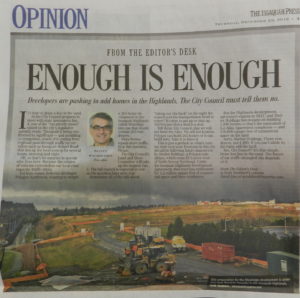
Stoddard signed off with a fateful demand: “Sorry Shelter Holdings. Three residences, not 1,800. If you can’t abide by the rules, sell the land. See City Council? It’s that simple. Draw a line in the sand. The future of our traffic strangled city depends on it.”
It may well be that uncomplicated, at least to a City Hall ethically bound to the best interests of its residents and the quality of life they’ve been charged with preserving, but unfortunately for Stoddard and his newspaper of note in the mountain town, reminding the city’s elders of their obligation doesn’t carry quite the weight that it should. Less than two month’s after Stoddard’s column was published The Issaquah Press was scuttled and sent to the bottom by it’s corporate parent The Seattle Times Company, ending the small daily paper’s 117-year run.
But Stoddard’s missive may not have been entirely in vain, at least for the moment. As Keith Niven, Issaquah’s Economic Development Director put it to me last month: “Shelter Holdings never gained community support for that proposal for 1,800 residences. Their post development agreement zoning allows for them to build commercial and retail on their property. They have moved forward with a number of land use applications.”
Shelter Holdings may not have got its 1,800 homes, but it is still on course to build, across three separate ‘collections’ on the jigsaw puzzle-like pieces of property that it owns in the Highlands, the more than 300,000-square-feet of commercial and retail development. And that massive commercial development will be flanked to the west with 73 single family homes in something called Westridge North Single Family and another 111 townhomes dubbed Westridge Townhomes North (albeit under the auspices of another developer) that will add another nearly 200 residential units to the Highlands in that area alone, which translated through the basic formula of reality means another 1,000 or more people and another 400 or more vehicles, non-inclusive of whatever the commercial development brings in between 5th Place NE and 9th Avenue NE on a daily basis.
So Stoddard’s stand was valiant, but it evokes King Canute and the tide of development continues. Niven’s cool observation that Shelter Holdings grand plans for a cauliflower of homes in Issaquah’s Highlands never gained “community support” may well be true enough but still begs the question just how much of the mountain town supported the debacle of Atlas, the vast cubist residential tumor that sprouted irrevocably on Gilman Boulevard and 7th Avenue NW a few years back, or how much of the town wanted to see the stacked Anthology Gateway Apartments now emerge on what but four years ago was a fine field alongside the I-90 marked notably with a small shack quaintly topped with a moss-covered roof?
How many popular votes did jamming another couple thousand people in that once green field garner?
Just across from the melanoma of Anthology on the southside of Newport Way NW is the entrance to Cougar Mountain Regional Wildland Park, a lush 28,000-acre sprawl of nature’s finest, Mother’s own brand of development that stands in a stoic-if-sad defiance of the humanity that now swarms around it as developers stand atop their land-movers like H.G. Wells aliens from the Red Planet, gazing upon it with envious eyes.
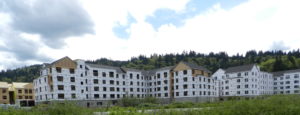
While there are no publicly known plans to plow into the park itself just yet, there are plans for what’s known in military terms as a ‘beachhead,’ a landing zone. Fifty-seven single family homes are on the board for something called the Bergsma Development that’s not technically in the park, but in an adjoining 45-acre lot that is part of what’s known colloquially as ‘the Issaquah Alps.’ Simply put, it is yet another deep slice of the variety now so easily glimpsed gashed into the hillsides from Newcastle to Snoqualmie.
The civic response to this has been something called ‘Save Cougar Mountain,’ a movement mostly evident by yard signs adorned with that slogan that have been planted around town on arterials where any vehicle moving more than 30 mph reduces it to a blip of a blur and a website, SaveCougarMountain.org, which provides a principled if somewhat academic argument against the pending encroachment.
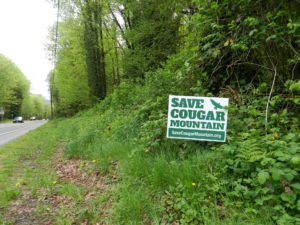
Noble as it may be, the anemia looks all so familiar.
Money talks and passive bullshit walks. By the time well intentioned souls start circulating flyers, posting yard signs and launching .org websites that start with the word ‘Save’ you can safely put your money on the horse named after the Carole King song ‘It’s Too Late (Baby)’ to win.
If there was any doubt as to where the rubber meets the road from Southern California to Northern Washington when it comes to the greater civic good and the protectionist ideal of preserving a standard quality of life versus the sheer power of not only developers but the corporate teat that feeds them, the Seattle City Council settled the question definitively last month when after unanimously passing in May a ‘head tax’ on major employers of 14-cents per hour for every employee—and lets be clear, this was aimed primarily at the major tech corporations that have strangulated the affordable housing and rental stocks in Washington—to raise a projected $45 million that would be pumped into efforts to ameliorate the city’s endemic homeless crisis, Amazon (and its accomplices) immediately spearheaded a full-force corporate bitch-slap across the council’s face, quickly chastening them into a humiliating reversal in a 7 to 2 vote that Councilwoman Lisa Herbold blubbered was the result of a fight the city could not win “at this particular time.”
Herbold’s shameless explanation of the council’s disgusting and cowardly reversal begs the question if the homeless crisis that has been exacerbated in no small part by filthy rich companies like Amazon isn’t a fight it could win now, when could it? Councilwoman Kshama Sawant at least had the courage to declare before the council’s reversal: “This is a cowardly betrayal of the needs of the working people.”
And it was. Yet it happened nonetheless, decisively.
From the epicenter of Seattle and its Mini-Me across Lake Washington, Bellevue, the shockwaves from the explosive build-out of Northern Washington rolls through towns like Issaquah, Sammamish and Snoqualmie, with new housing tracts breaking north up Washington State Route 203 and into the verdant farmland and the communities of Carnation and Duvall, its reverberations reaching into the previously quaint hinterlands of places like Anacortes along the upper-crust of Fidalgo Island and over the Cascades through the Snoqualmie Pass and into old mining outposts like Cle Elum, altering landscapes as it enlarges economies and increases rents, leases and mortgages build-by-build, development-by-development, project-by-project, even as it reduces the quality of life in everyone of those communities and the state writ large.
In Anacortes, a harbor town that is poured one part working class hardscrabble of the ship-building and oil refinery variety, one part fine reflection of historic accomplishment and yet these days increasingly topped off with an aggressive tilt of the nouveau riche development bottle, the consequence of reconfiguring a community in increments, like so much civic plastic surgery, is quickly evident. Like a deep cap of Galliano, legacy housing with all of its space and individual character that ran on either side of Oakes Avenue that carries motorists out of the old downtown and to waiting ferries just a stone’s throw west of the Ship Harbor Inn that are bound for the islands of Lopez, Orcas and San Juan are disappearing and being replaced by collections of shit-box insta-homes and faux Hamptons seaside houses that cater expressly to a sense of cocooned entitlement that stands in stark contrast to the town’s long established character.
The development of San Juan Passage, which began to sprout along the shoreline just east of the Ship Harbor Inn in 2016, is Exhibit A of just how fast and completely a municipal makeover can take root. Billed as ‘The retreat you’ve always dreamed of…styled for year round living,” marketing materials for the development promised ‘water’s edge view homes’ on stunning lots between a cozy 2,677-square-feet and a more comfortable 3,414-square-feet for prices that opened at $1.2 million. On the early one-sheets promoting the project the wild-bidding that had decades ago become a fixture in Southern California’s housing market were on full display at San Juan Passage, with original prices literally covered in Liquid Paper and new prices handwritten in, that $1.35 million suddenly bumped to $1.5 million so fast that a new pressing was out of the question, they had to just start manually altering the price tag. I thought it would have been a nice touch if they just would have X’ed it out and written the new price in, maybe with a smiley face for good measure.
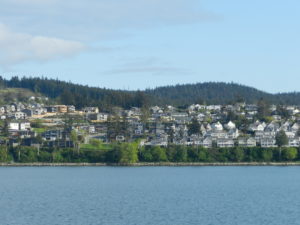
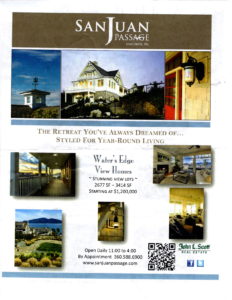
Or perhaps, like Maine lobster on the menu, simply written: ‘daily market price, inquire with your waiter.’
It’s a late morning at the Anchor Inn Tavern, a proper working class joint that opened in the 1930s and sits on the main drag of Commercial Avenue that feeds into the old downtown of Anacortes, and I find myself on a familiar barstool and nursing a familiar drink; double Stoli on the rocks with two limes. The local early birds are here, all five of them, all older white cats spaced appropriately apart and along with me looking like a chorus line of Hemingway in various states of disintegration, admiring our glasses as we consider what went wrong after it had all been quite right for so long, old Ships-of-The-Line lingering on the horizon as the bulkheads creak and moan before the final run falls upon us.
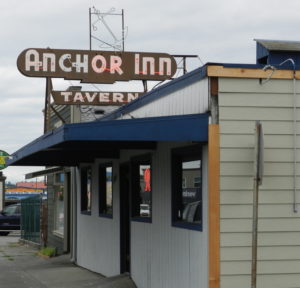
The bartender, Kana, who happens to also be the owner, is originally from Ventura and we trade reflections on the California that once was and the great exodus of its middleclass that has befallen the state as its implosion has accelerated over the past generation. Her old hometown was once a sleepy little coastal burg surrounded by lush farmland that unspooled around motorists as they made their way along U.S. Route 101 as it winds from Thousand Oaks through the pass and then down the westerly slope into Camarillo and then through Oxnard before entering Ventura and holding onto the coastline up to Santa Barbara. More than thirty years earlier I had made that trip often and hit the old Ventura County Fairgrounds throughout the mid-1980s to dance and dig the Grateful Dead’s sweeping resurgence on the California shore, but it’s all gone now. Well, most of it is anyway. Buried under the slow roll of bulldozers that replanted the fertile fields with seas of townhomes and outlet-anchored malls selling China off-the-rack.
Kana tells me that she and her husband had planned their escape from California carefully, finally choosing the Northern Washington port town of Anacortes only after considering bars for sale—they were looking for a bar to buy wherever it was they landed—all over the country, but the Anchor Inn was the first one they actually walked through and, initially, they took a pass. They placed an offer on another joint somewhere else, but after that fell through they returned to Anacortes and bought this beautifully authentic little watering hole and moved down around Deception Pass.
But the push-factor from Southern California was not terribly far behind them.
Kana tells me that rents all over town have jumped dramatically, by her estimation fueled in part by the naval air station on Whidbey Island (officers and servicemen looking for off-base housing) but the housing ecosystem has also been jolted by developers gobbling up land to raze existing homes and replace them with either luxury homes or knock-offs more densely packed together. How long the farmland that straddles much of Washington State Route 20 between the Salish Sea and Interstate 5 will last is uncertain, but its eventual fate is not and the garish transformation of the farmland that once blanketed the Ventura coastline is a grim augury of what awaits the fields and farm houses.
Unlike Issaquah now, Anacortes still has a hometown newspaper that’s hanging on and the roil of development must play some role in keeping the Anacortes American rolling off the presses and into homes around the island as well as the news racks that still dot the old downtown. The newspaper’s offices, housed in a charming building on Sixth Street where it has operated since 1913, is just a stone throw from the shipyards and the gemstone of the Majestic Inn that was built in 1890, though not as today’s hotel that during the summer months offers a fine rooftop bar with a sweeping view of Guemes Channel, as well as the dozens of shops, cafes, boutiques, vessel charters and random little retail oddities (such as The Business, a tiny record store that features bins of albums for which the customer names the price) that define the still-beating heart of the town. But if real estate sections and supplements alone were enough of a revenue infusion to sustain a small town newspaper, then The Issaquah Press would surely still be alive today. But its an interesting proposition for newspapers throughout Washington today: bite the hand of developers that provide at least some of the cash that feeds their already anemic revenue flows and readership bases?
That question was answered years ago in Southern California by the Los Angeles Times, which decided to take a position on the waves of development and growth consuming the region that ranged between occasionally agnostic to unabashed advocate, usually purposing its news and editorial pages as an extension of the Chamber of Commerce to advance an agenda of accommodating growth at virtually any cost to the state’s quality of life. On May Day, 2015, the newspaper of record in the City of Angels published a front page feature story headlined ‘Lawn’s End’ that declared California suburbanites had to confront the reality that the ‘arid West is no place for a frontyard carpet of green.’ Reporter John M. Glionna’s lede aptly set the stage: “When Gov. Jerry Brown ordered that California rip up 50 million square feet of lawns to conserve water amid the West’s deadening drought, the Golden State gasped. Meanwhile, the Silver State yawned.”
Using Las Vegas as its water conservation counterpoint, Glionna’s piece doesn’t waste much time before it gets to its first quoted source; author Michael Pollan from Berkeley, who went on record to declare that lawns were “absolutely absurd” and would one day be looked upon as akin to “littering, smoking in bars and public urination.”
While Glionna’s story is a well-written waltz played across a grassy dance floor, it took its familiar rhythmic turns without stepping on the toes of the developers that have filled Greater Los Angeles and Las Vegas with a population surge that has not only remade Southern California and Southern Nevada but has transformed them into portraits of dysfunction. A photo from Sin City appears in an above-the-fold photograph on A1 that captures what Glionna and his editors determined is the wave of the future: a row of identical new homes jammed together in the Nevada desert sans the now deadly greenery of front lawns. In fact, the ‘homes’ are practically built out onto the sidewalk. And though the case for lawns is made, both aesthetically and in terms of utility (think oxygen, soil erosion and heat abatement), Glionna is fastidiously careful to not mention—even in passing—the bacchanal of building that has carpeted the Mojave Desert not so much with water-consuming lawns as a sea of homes that house a never-ending tide of people that impact not only water resources but tax virtually every other natural asset as well.
It’s a fascinating omission, and a telling one.
But like the doomed small town daily The Issaquah Press in Northern Washington, the rampant growth throughout Southern California is unlikely to save a former behemoth like the Los Angeles Times. The once mighty newspaper the Chandler family built continues its end-stage transformation, with its long strangulation at the hands of the Chicago outfit known as Tronc, Inc., which operates effectively as a Murder Incorporated for the newspapers it owns, finally coming to an end this June when South African billionaire Patrick Soon-Shiong bought the paper and promptly announced he was shuttering its fabled downtown LA headquarters and moving its editorial remains to a soulless growth of a corporate office building on Imperial Highway in El Segundo.
Tronc had sold the historic Los Angeles Times building back in 2016 to Canadian developer Omni Group, which then leased it back to the newspaper before announcing plans to demolish it and raise residential luxury towers in its place.
Just as a goof, Soon-Shiong should have relocated the ‘Los Angeles’ newspaper to Oceanside and consolidated it with the San Diego Union Tribune, which he also bought from Tronc, and then debuted an editorial mutant topped with a nameplate of Los Diego Union Times outfitted with a couple dozen reporters to cover the region from Tijuana to Tujunga and made what remains of the growth-at-any-cost cadre formerly of Spring Street either move or drive four hours back and forth to work each day. Now that would have been a hoot, well, in a sad comeuppance-via-karma sort of way, but one that may yet still happen as Soon-Shiong’s executive management team considers ‘new efficiencies’ for the not-so-brave new world that is devouring the landscape whole.
A storm rushes across the Rosario Strait and the jukebox suddenly makes like The Shining and cues up The Carpenters ‘Rainy Days and Mondays’ and we sit inside the Anchor Inn in Anacortes talking development, growth, newspapers and the quality of life as if its now reduced to scattered game preserves. It’s a Monday. Now it’s raining. And perhaps what we feel has come and gone before, though I am not so sure, but Kana and I start laughing at the serendipity of it just the same.
It’s all mucked up, so let’s have another round along the bar. And we do.
In the Cascades, the former mining town of Cle Elum has also felt the reverberations of Greater Seattle’s growth, a human shockwave that has rolled over the Snoqualmie Pass with repercussions that have killed mom and pop storefronts and replaced them with big box shit dumps that cater to the cold bottom line. I was reminded of this one afternoon as I walked out of The Caboose, a fine joint where the pours are blessedly jigger-free and standing on the back patio for a smoke you can suddenly find yourself listening to Firefall’s first album coming off the juke, and made my way east along the northside of 1st Street to discover that the long-standing Cle Elum Drug was no more. It’s classic street front sign gone, its windows no longer adorned with inducements to step inside, its long stretch of narrow aisles empty. Another cadaver left on Main Street, USA.
As I ponder the shell of what once was a cozy bedrock business dedicated to the better health for the working folk in this town a couple that had also been in The Caboose walk up behind me and the dude offers a simple “Yeah, it’s gone.”
“What happened?” I ask.
He and his lady didn’t miss a beat, answering in unison: “Safeway.”
Joel and Allison own Erwin’s Altered Americana just across 1st Street and they’ve watched the flow without ebb reach even into the elevation of Cle Elum. As we stand on the one street of this beautiful one street town they explain that the big box drug retailer that rose like a towering inferno on the western stretch of 1st Street spelled a death sentence for Cle Elum Drug and its band of workers, some of whom were promised jobs by the chain brand. After the small local drug store closed down, they tell me a local bought its sign in order to save it.
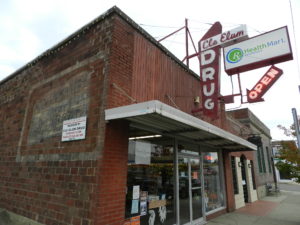
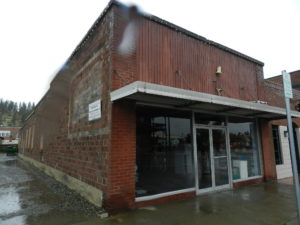
As for what the store represented up here, its fate remains to be seen.
“Rents here are going up,” Joel tells me.
“Retirees?” I ask.
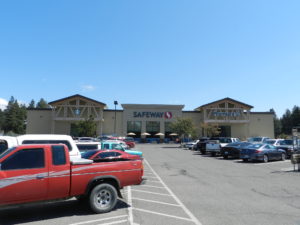
“No, tech commuters,” he says.
“How do they reliably get back down the pass from late November to March?” I ask.
“You got me,” he says. “But they are coming.”
Tech commuters in Cle Elum? Why that sounds about as possible as, well, states that allow wild building sprees and population pumps without any consideration whatsoever as to what that really means for the existing infrastructure or the architecture required to accommodate it or the impact on life in its entirety.
It’s late July and Southern California is burning, as now per usual. And fire season doesn’t even really officially start until September. It’s a collective blaze that still makes the news in all of its roaring waves of candy orange glory, capturing if only for a brief spell of eventually no consequence the immensity of its devastation that’s always followed by grim post-mortems about what can be done to prevent the next inferno—with the exception of even pausing the building.
That’s never a possible remedy, let alone the solution.
As I watch my native Southern California’s annual ‘flame on’ from a comfortable if precarious perch in Northern Washington, I consider whether or not I really care anymore or if I’m just enjoying the light show as I run down the clock on my own earthly tour and maybe sharing some notes along the way.
Some days it’s hard to tell.
But I do know this much: from Sacramento to Olympia, the suits don’t even pause that long to consider where they’ve been, what they’ve done or where it’s all going and what it means for everyone else.
And as Washington watches the California bonfire tonight under a Blood Moon, well, I wonder how many of them truly grasp what the spectacular glowing rain of its embers actually means for life up here.
Because if they don’t already, believe me, they soon will.










